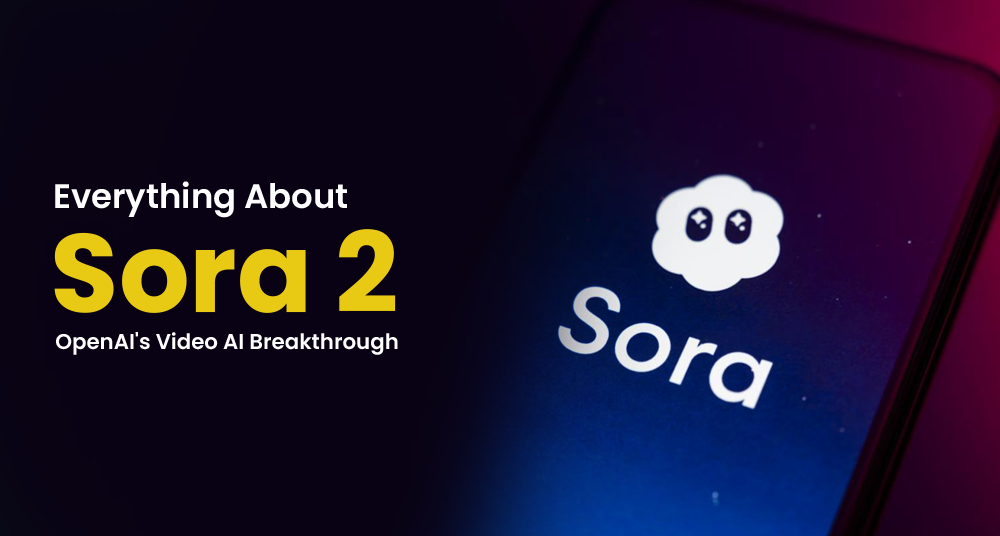In late 2025, OpenAI dropped a bombshell in the world of AI content creation: Sora 2 — a video and audio generation AI tool that’s turned heads, sparked debates, and shifted what’s possible. Whether you’re a creator, marketer, developer, or just curious about how AI is reshaping media, Sora 2 is a name you need to know. This post digs in: what Sora 2 is, how it works, its strengths and limitations, controversy, safety, use cases, and what’s coming next.
What Is Sora 2?
Sora 2 is OpenAI’s next-generation video & audio generation model, released September 30, 2025. It builds on the earlier “Sora” model, adding features that significantly increase realism, control, and flexibility.
Rather than a simple silent video clip generator, Sora 2 combines synchronized audio, realistic motion and physics, user-“cameos” (i.e. inserting one’s own likeness), and stylistic variety. It is embedded in a new dedicated app (invite-only initially in iOS, U.S. & Canada) plus web-based tools, with hints toward API access in the future.
OpenAI describes Sora 2 as a leap forward: sharper realism, better controllability, more believable world simulation, all while making creativity accessible. This has led many to call its launch a “GPT-3.5 moment for video.”
Key Features & Technical Highlights
Here are the standout features that distinguish Sora 2 from earlier AI video tools and from its predecessor:
Audio + Visual Synchronization
One of Sora 2’s biggest upgrades is synchronized audio — generating dialogue, sounds, ambient noise along with video, and ensuring visuals match (lip movement, environment, etc.). Earlier tools often had generic audio or no sound. This shift makes generated clips more immersive, more usable “out of the box” (for sharing, storytelling, social media).
Realistic Physics & Motion
Sora 2 models more accurate physics: objects bounce naturally, gravity behaves more plausibly, collisions or movements aren’t just “teleported” or illogically distorted. It includes environmental reactions (for example, things behaving physically plausible when interacting) rather than just stylized motion.
Cameos / Likeness Insertion
Users can insert themselves (or objects/friends) into Sora 2 videos via the “Cameo” feature: recording a short video + audio to capture likeness, voice etc. Then that likeness can be used in subsequent generated clips, with permissions. There are identity verification, control over who can use the likeness, revocability. This gives more control, though still under scrutiny for misuse potential.
Stylistic Range & Prompt Control
Sora 2 supports various visual styles: cinematic, photorealistic, animation/cartoon styles, etc. Users can specify style, camera angle, lighting etc. Prompts can span multiple scenes or shots while maintaining consistency — e.g. same character, props, settings persist properly through prompt transitions.
App & Social Features
Sora includes a “feed” or social component: videos are shared, viewed, liked, remixable (users can take existing clips and tweak prompts or insert their own cameos) akin to TikTok / Reels style feeds. Invite-only rollout initially in U.S. & Canada for iOS; Android version expected later. Web-based usage also possible in some form.
How Sora 2 Is Shaking up The Creative Landscape?
With those features come big implications:
Democratization of Video Creation
People without video editing skills, equipment, or big budgets can generate short video content quickly from text prompts. This lowers the barrier for creative content, social media clips, promotional videos, etc.
New Forms of Expression & Personalization
The cameo feature allows deeply personal content: people can “star” themselves in created short films, ads, or imaginative scenarios. Combined with styles, prompts etc., this opens up novel storytelling formats.
Competition with Social Media & Short-Video Platforms
Sora 2, with its feed & short-video format plus user sharing, is positioned to compete with TikTok, Instagram Reels, YouTube Shorts, etc. OpenAI appears to be building a tool that isn’t just generative but social.
Marketing, Advertising, Education Use Cases
- Marketers can use it to generate promotional clips fast.
- Educators or trainers can illustrate concepts visually easier.
- Artists & filmmakers can prototype scenes, experiment with visuals or styles.
Region / Access / Rollout
Sora 2 is still in early phases. Important points about where and how people can use it:
- Currently invite-only for the official Sora app on iOS. Only available (initially) in US and Canada.
- Android version is not yet fully rolled out. OpenAI has hinted at broader availability in future.
- There are fake clones or misleading apps on App Stores using Sora name — users must ensure authenticity.
Risks, Challenges & Ethical Concerns
With power comes responsibility, and Sora 2 is under serious scrutiny in several areas.
Copyright & Intellectual Property
Sora 2 has rapidly generated videos featuring copyrighted characters (e.g. SpongeBob, Pokémon, South Park). Owners worry about unauthorized usage. OpenAI is working on giving rights holders more granular control or opt-out options. The “opt-out vs opt-in” framework is contentious: by default, many things may be allowed unless someone explicitly excludes them. That causes legal and ethical friction.
Deepfake / Likeness Misuse
The cameo and likeness insertion options, while powerful, also enable misuse if people use someone else’s identity without consent. OpenAI has built in controls (verification, permissions, revocability), but enforcement and detection remain important.
Misinformation & Harmful Content
Already, Sora 2 has been criticized for some content users have generated: violent, racist, misleading content. Even with filters, content slipping through has been reported. Ensuring accuracy, preventing disinformation, and defaulting to safe defaults is a major ongoing challenge.
User Privacy & Data Security
Capturing user likeness, voice, and sharing them—even with permissions—raises privacy concerns. How that data is stored, secured, used, and potentially exposed is under intense scrutiny.
Regulation & Legal Jurisdiction Issues
Because Sora 2 blurs reality, legal responsibility, rights over content, liability for harmful content, trademark etc., will be tested in different jurisdictions.
How to Use Sora 2: Practical Tips & Best Practices
If you have access or plan to use Sora 2, here are tips to make the most:
- Write Clear Prompts: Include style, setting, mood, characters, motion description. The more specific, the better the results.
- Use Cameo Carefully: If using your likeness, verify, set permissions, control who can use it. Keep safety & consent front and center.
- Choose Appropriate Style: Test different aesthetic styles; sometimes animated or stylized looks mask limitations in realism better than ultra-photo realistic.
- Start with Short Clips: Because of processing, limits, risk of generating outputs that are blocked (copyright etc.), short clips (10 seconds or so) are safer.
- Be Aware of Limits: Some motions may still glitch; audio sync may not be perfect for complex interactions; certain materials (copyrighted content or logos) may trigger blocks.
- Respect Community & IP Norms: Don’t create content that falsely depicts real people in harmful ways or unauthorised use of copyrighted characters.
- Monitor Updates: Because the product is new, features, limitations, policies will change quickly. Stay updated via OpenAI blog, system card, community feedback.
Reception & Controversy
The rollout has been high-energy but not without conflicts.
- Sora 2 hit #1 in Apple App Store quickly after launch in US/Canada.
- Social media is buzzing: some users excited, others concerned. Critics have labeled some content “AI slop,” worrying about randomness, glitches, IP risks.
- Fake apps & clones have proliferated, creating confusion and potential security risks for users.
- Rights holders are pushing back. OpenAI is promising more control for copyright owners; processes and opt-out mechanisms are being refined.
- Safety teams are under pressure: detecting harmful content, ensuring policies work as intended, handling community complaints.
Business & Commercial Implications
What Sora 2 means in terms of markets, business models, and competitive pressure.
- OpenAI is positioning Sora 2 not just as a novelty, but as part of its creative toolset. Eventually via API and integrations (e.g. with ChatGPT) this could be a revenue stream.
- Brands, advertisers, creators will find it an appealing tool for rapid content generation. Speed + style vs traditional video production could disrupt parts of marketing budgets.
- Competitors (Google, Meta, ByteDance, etc.) are likely to respond; Sora 2 raises the bar for audio-video realism in generative media.
- There are business risks: legal liability, IP infringement claims, content moderation costs, public backlash — these need to be managed.
Where Sora 2 Excels—and Where It Falls Short
Strengths
- High realism & immersion (sound + motion + physics)
- Cameo personalization is a strong differentiator
- Strong prompt control & stylization
- Easy social sharing & remixing — good viral potential
Weaknesses / Current Limitations
- Geographic & device limitations (invite-only, iOS in specific regions)
- IP / copyright risk; filter/takedown regime still developing
- Some content quality issues: handling complex human movement, intricate interactions, some glitchy artifacts reported.
- Risks of misuse (deepfakes, misinformation) cannot be ignored.
- Usage limits / access constraints may frustrate users.
What’s Next? What to Expect
Looking forward, here are things to watch:
- Wider rollout: Android, more countries, more open access.
- API availability: enabling developers to integrate Sora 2 capabilities into apps, tools, services.
- Evolving safety & IP norms: more granular control for content owners, better filters, clearer policies.
- Higher resolution, longer video durations. As compute improves, we’ll likely see Sora 2 or successors support longer clips, better detail.
- More styles, domain-specific templates: e.g., marketing, education, film pre-visualization, etc.
- Possible monetization models for creators: revenue sharing, premium content, licensing, etc.
- Ethical & regulatory push: privacy laws, deepfake laws, copyright enforcement will shape product parameters and public reception.
Why Sora 2 Matters: Big Picture
Sora 2 is more than a cool app — it represents a tipping point in AI video generation. Key reasons it matters:
- It signals that generating fully realized short video content (audio + motion + realism) is now within reach for many users, not just studios.
- It accelerates creative democratization.
- It changes what “content creation” means — less about editing, filming; more about imagination and prompt engineering.
- It will force platforms, regulators, businesses to adapt to an environment where visual content can be faked, remixed, shared in seconds.
- It may shift competitive dynamics in social media, media production, advertising, creative industries.
Final Thoughts
Sora 2 is a landmark for AI video generation. It’s not perfect — there are trade-offs, limitations, and risks — but the speed, realism, and features it offers are pushing the envelope in creative tech.
If you have access, experiment with prompts, explore the cameo features, test different styles. But do so responsibly: mind the IP rules, privacy settings, and be aware that the field is evolving quickly.
For creators, this is a huge opportunity. For regulators and rightsholders, a major challenge. For everyone else — whether as consumer or viewer — Sora 2 promises new kinds of visual media, with all the wonder and pitfalls that innovation brings.
FAQs
What is Sora 2?
Sora 2 is OpenAI’s next-generation AI tool for generating realistic videos with synchronized audio, motion, and style control. It allows users to create personalized short clips using text prompts and “cameos.”
How can I access Sora 2?
Currently, it’s invite-only on iOS in the U.S. and Canada, with a web version available. Android rollout is expected in the near future.
Can I insert my own likeness into videos?
Yes. The “Cameo” feature allows you to insert your face and voice into generated videos, with permissions and revocability to prevent misuse.
Is it safe to use Sora 2?
OpenAI implements safety filters, IP controls, and privacy measures, but users should avoid creating harmful, copyrighted, or deepfake content.
What kind of videos can I generate?
Sora 2 supports multiple styles: photorealistic, cinematic, animated, or stylized videos. Prompts can control characters, environment, camera angles, and more.
What are the main risks of using Sora 2?
Risks include copyright infringement, misuse of likeness, misinformation, and glitches in complex motions. Always follow OpenAI guidelines and legal regulations.
Related Blog: ChatGPT vs Google Gemini






What do you think?
It is nice to know your opinion. Leave a comment.